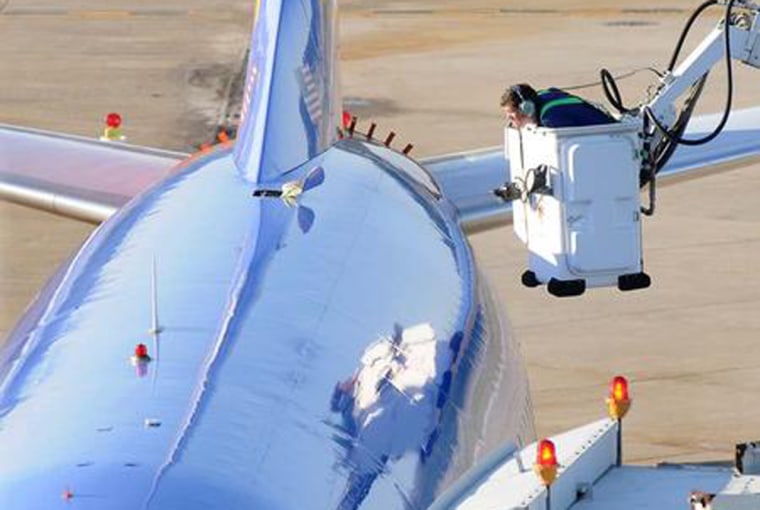Federal safety officials are investigating how a foot-long hole opened in the top of a Southwest Airlines jet, forcing the aircraft to make an emergency landing in Charleston, W. Va.
The Boeing 737 jet lost pressure in the cabin, but no one was injured on Monday's Nashville-to-Baltimore flight that carried 126 passengers and five crew members.
Southwest said Tuesday that it inspected all 181 of its identical Boeing 737-300-series jets overnight before putting them back in the sky.
Passenger Michael Cunningham told NBC's "Today" show Tuesday that he had dozed off in his seat in mid-cabin when he was awakened by "the loudest roar I'd ever heard," and saw the hole above his seat.
Cunningham said people stayed calm and put on oxygen masks that dropped from the ceiling.
"After we landed in Charleston, the pilot came out and looked up through the hole, and everybody applauded, shook his hand, a couple of people gave him hugs," he said.
Southwest said it was unclear what caused the hole, which ripped open just in front of the vertical tail fin as the plane cruised at 30,000 feet. The jet flew that way for nearly half an hour to Charleston.
The National Transportation Safety Board sent an investigator to the scene to interview the crew and examine maintenance and inspection records, but could take months to find a cause, said agency spokesman Keith Holloway.
The incident occurred just four months after Southwest agreed to pay $7.5 million to settle charges that it operated planes that had missed required safety inspections for cracks in the fuselage.
Southwest spokeswoman Marilee McInnis said the airline inspected its Boeing 737-300-series jets overnight at hangars around the country and discovered no cracks in any of the others.
"It was a walk-around visual inspection just to check for structural integrity," McInnis said.
The 137-seat 737-300 makes up about one-third of Southwest's fleet. All its 544 jets are various models of the Boeing 737.
No cancellations, delays
The planes that were inspected overnight were put back into routine service Tuesday morning, while the airliner that landed in West Virginia stayed there. Representatives from aircraft manufacturer Boeing were helping to determine cause of the hole, McInnis said.
Southwest operated a normal schedule of flights — about 3,300 per day — with no cancelations or delays through midday, McInnis said.
The hobbled airliner was placed in service during the 1990s and went through "routine maintenance" this month, McInnis said.
Experts said the tear could have been caused by damage from a dent or ding, or the plane's skin could have suffered from age-related fatigue. Jet cabins are pressurized and depressurized with every flight, which can cause tiny cracks over time. The Southwest jet was built in 1994.
Bill Voss, president of the Flight Safety Foundation in Alexandria, Va., said a finding of fatigue would be more frightening. If that were the cause, it could force the FAA to consider more rigorous inspections for older aircraft, he said.

Alten "Skip" Grandt, an aeronautics professor at Purdue University who specializes in structural analysis, said that the fuselage of the Boeing jet performed as designed by preventing a sudden and catastrophic loss of pressure, and stopping the hole from expanding.
The cabin depressurized, he said, "but whatever caused that hole, it didn't cause the whole airplane to blow up."
In 1988, cracks caused part of the roof of an Aloha Airlines Boeing 737 to peel open while the jet flew from Hilo to Honolulu. A flight attendant was blown out of the plane and plunged to her death, and dozens of passengers were injured. The incident led to tougher rules for inspecting fuselages.
In March, Southwest agreed to pay a $7.5 million civil penalty imposed by the Federal Aviation Administration for operating nearly 60,000 flights in 2007 on planes that had not undergone required inspections for cracks in the fuselage. About 1,450 flights took place after the FAA had notified Southwest of the missed inspections.
The settlement with the FAA also required Southwest to increase oversight at companies to which Southwest outsources maintenance work, and to give FAA inspectors more access to information used in tracking maintenance activities.
Dallas-based Southwest Airlines Co. carries more than 100 million U.S. passengers a year, more than any other airline.